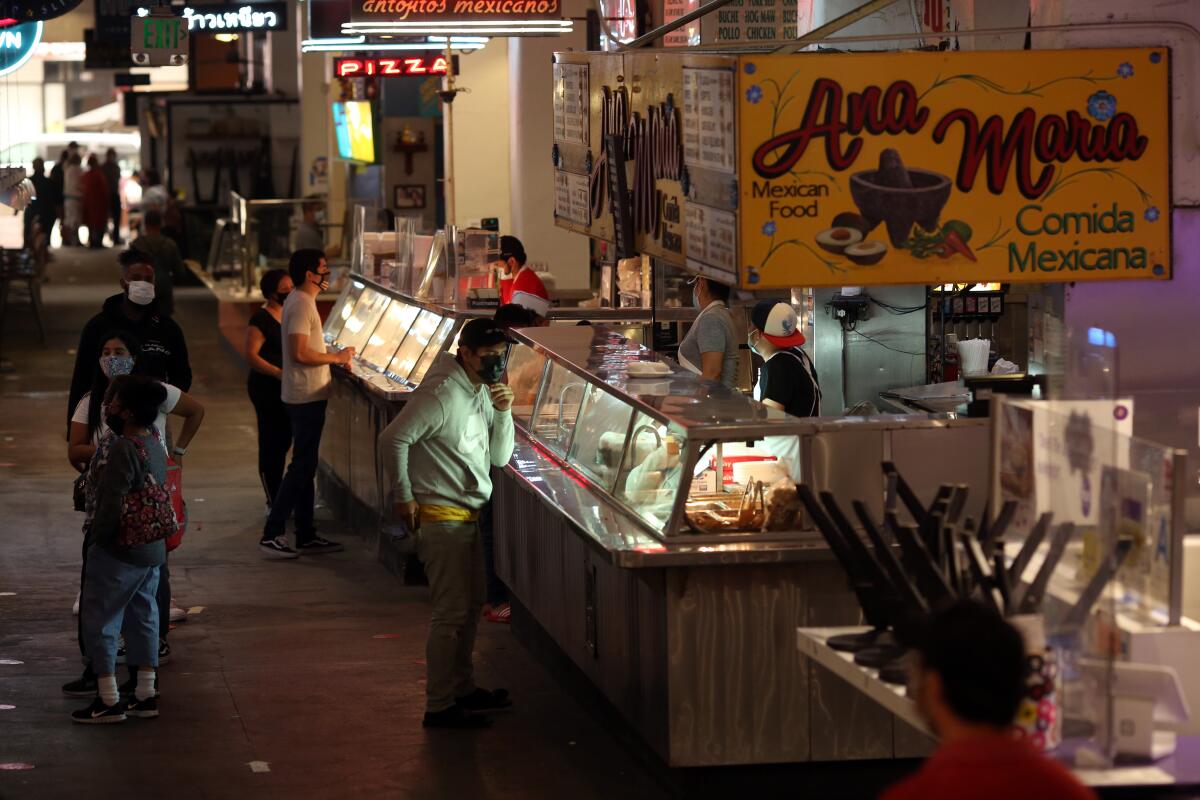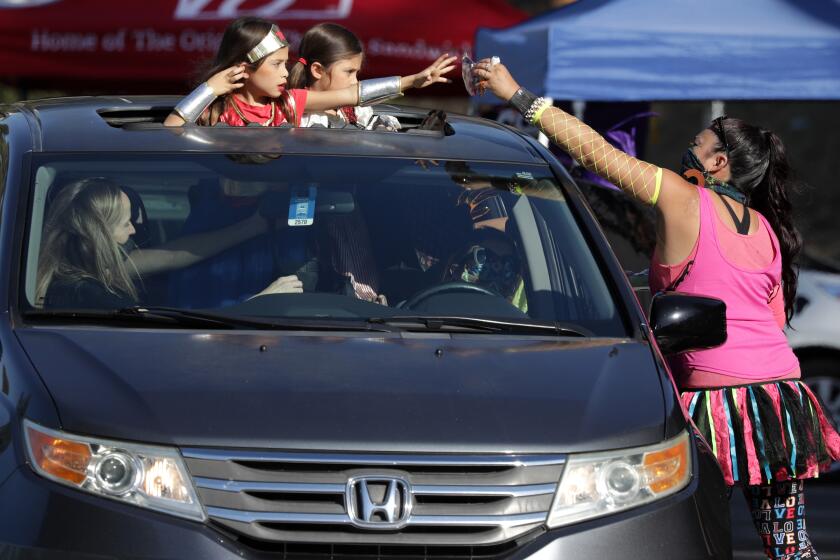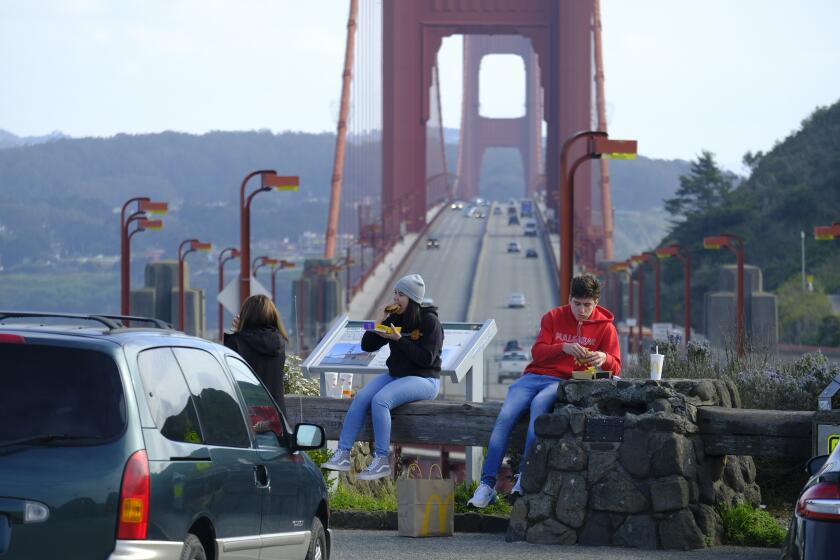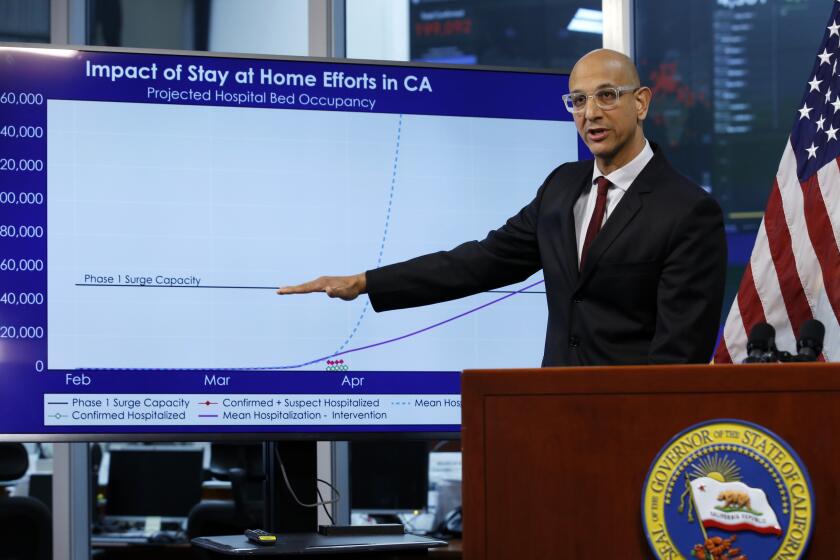L.A. County coronavirus cases hit highest daily level in three months

Los Angeles County logged 2,065 new coronavirus infections Thursday, a single daily case count one health official said hasnât been seen in the region for months.
Over the last two days, health officials have announced roughly 3,900 new coronavirus cases in the county and on Thursday there were 25 additional deaths, totals reflecting what has long been warned: The disease is still spreading, and residents need to take precautions to keep the number of infections from climbing further.
Though a spike in cases last month was attributed to a backlog of reported tests, the most recent increases are not associated with delays in reporting, public health officials said. The last time the daily case count was this high was Aug. 15, according to The Timesâ tracker.
L.A. Countyâs seven-day average of coronavirus cases has also increased from about 940 new cases a day in early October to more than 1,275 each day as of last week, health officials said.
In announcing an elevated number of positive cases on both Sunday and Monday â days when the county typically reports fewer new cases because of reporting lags over the weekend â Public Health Director Barbara Ferrer said âif that trend holds true, weâre going to see higher numbers the rest of the week.â
Health officials say itâs unlikely Los Angeles County will see any movement on the stateâs reopening tiers in the coming weeks.
In another troubling trend, the projected transmission rate has again surpassed 1.0 in L.A. County. That means the number of people who could contract the virus from one infected person is probably rising.
Itâs estimated that 1 in 670 residents are infected with the virus, county health officials reported Wednesday. Last week, that estimate was 1 in 1,000.
âI thank all of our businesses, schools and residents who continue to make COVID-19 safety measures part of their daily routine,â Ferrer said in a statement.
âUnfortunately, the continued significant increase in cases reflects many instances where basic prevention measures were lacking,â she said. âUnless we can all get back to protecting each other, our recovery will stall.â
The rise comes as the country enters what experts have said will be a particularly dangerous period of the pandemic.
Officials have said that private gatherings are greatly contributing to the stateâs increase in cases and that residents should continue to follow oft-recited infection prevention protocols: Practice physical distancing, wear masks in public, stay home when youâre sick, and regularly wash your hands.
Falling temperatures will increasingly push people indoors â where the coronavirus can more easily spread â and approaching holidays will tempt residents to gather with family and friends outside their households, heightening their infection risk.
âWe do worry, with the colder weather, more people being inside, the fatigue, people wanting to socialize more, the holidays coming, all of that creates a mix of circumstances that could lead to an accelerating increase,â Dr. Paul Simon, chief science officer of the L.A. County Department of Public Health, said during a briefing Thursday.
The Bay Area holiday quarantine proposal will likely be a âstrong recommendation,â not an order, says Matt Willis, Marin County public health officer.
Recent data show that California has seen an increase in its statewide positivity rate for infections from 2.6% to 3.3% over the past 14 days.
Despite the uptick, California Health and Human Services Secretary Dr. Mark Ghaly said the stateâs rate still compares favorably with the rest of the country, as the test positivity nationwide is about 6.7%.
âAlthough weâre seeing some trends up here in California, those trends are modest, steady. Weâre watching them closely, and certainly [they are] not the same as many of the states throughout the nation,â he said during a briefing Wednesday.
However, the statewide number of COVID-19 hospitalizations has also increased by 13.5% over the past 14 days, and the number of patients in intensive care has grown by nearly 20%.
Though Ghaly said those numbers are not inherently surprising â âwe always know when we see increases in our case numbers that roughly three, three-and-a-half weeks later, weâll see that manifest in hospital increasesâ â a significant and sustained surge in new patients âwill put our hospitals in a difficult position during flu season and when weâre trying to keep up with all other routine healthcare.â
California has so far avoided a major new wave of coronavirus cases, but a rising transmission rate and hospitalization numbers have officials concerned.
Aside from the potentially devastating health effects, any growth in infections also jeopardizes the ability of California counties to relax coronavirus-related restrictions on businesses, schools and other places and activities.
Californiaâs four-tier, color-coded reopening roadmap is based on two metrics: the seven-day average of daily COVID-19 cases per 100,000 residents and the testing positivity rate.
Counties can move into less-restrictive tiers if their numbers improve or backslide if conditions worsen for two consecutive weeks.
Two counties moved backward Wednesday: Shasta regressed to Tier 1, the most restrictive âpurpleâ tier, and Plumas moved back to Tier 3, or âorange.â
San Diego County, currently in the âredâ Tier 2, also is at risk of regressing to Tier 1. While in that category, a countyâs schools, many businesses and public facilities either cannot operate indoors or can do so only in a strictly limited capacity.
L.A., Riverside, San Bernardino and Imperial counties are in the purple tier.
Given that cases are on the upswing in L.A. County, Simon said he doesnât âthink weâre going to get to that next tier anytime soon, but weâre obviously watching the numbers closely.â
âWe have mixed feelings about jumping into the next tier,â he said. âOn the one hand, we want to open things up as much as possible. At the same time, we donât want to do anything reckless that will result in a new surge and then require that we move backward again.â
A second purple score next week would cause region to fall into stateâs most-restrictive reopening tier
With no end in sight, officials acknowledge that Californians may be understandably experiencing some pandemic fatigue, growing weary of living under restrictions that have been in place for nearly eight months.
Ghaly said residents should be applauded for their efforts.
âWe know that the pandemic has altered our way of living,â he said. âWeâve all made sacrifices â some weâve been OK with, others have been really hard â and each of these sacrifices has helped us slow the spread of COVID in our state. And I would say Californians have done an incredible job.â
But, he emphasized, residents need look no further than other parts of the U.S. to see how quickly the coronavirus can roar to life.
âWe have to keep these efforts up,â he said. âAs we know, cases can begin to skyrocket quickly.â
Thatâs a reality facing much of the nation now as the coronavirus continues to surge to staggering heights.
Daily new confirmed coronavirus cases in the U.S. have risen 45% over the past two weeks, to a record seven-day average of 86,352, according to data compiled by Johns Hopkins University. Deaths are also on the rise, up 15% to an average of 846 deaths every day.
Collectively, the country reported roughly 103,000 new cases on Wednesday, the most in any one day to date, according to the COVID Tracking Project.
Daily new case loads topped 1,000 in 34 states â also a record, according to the latest project data â and the number of hospitalized COVID-19 patients peaked in 16 states, including many in the Midwest.
Simon called breaking the 100,000-daily-case barrier nationwide âa very sad milestone.â
âItâs a number, but we canât forget the sort of personal pain, suffering and trauma that thousands and probably millions of people are experiencing,â he said.
The Associated Press contributed to this report.
More to Read
Sign up for Essential California
The most important California stories and recommendations in your inbox every morning.
You may occasionally receive promotional content from the Los Angeles Times.















